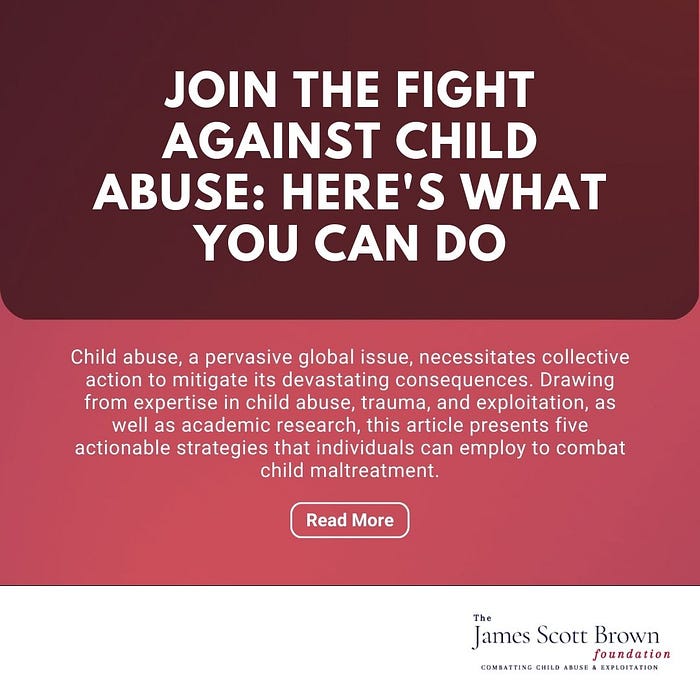Join the Fight Against Child Abuse: Here’s What You Can Do by James Scott Brown Foundation
by James Scott Brown Foundation

Abstract:
Child abuse, a pervasive global issue, necessitates collective action to mitigate its devastating consequences. Drawing from expertise in child abuse, trauma, and exploitation, as well as academic research, this article presents five actionable strategies that individuals can employ to combat child maltreatment. Through involvement and informed action, each person can contribute to the fight against child abuse.
- Educate Yourself and Others:
Acquire a comprehensive understanding of child abuse, its indicators, and ramifications. Disseminate this knowledge within your social networks, fostering informed discussions and raising awareness (Sedlak et al., 2010).
2. Recognize the Signs:
Familiarize yourself with the common signs of child maltreatment, such as unexplained injuries, sudden behavioral changes, or neglectful appearance. Early detection can facilitate intervention and prevent further harm (Gilbert et al., 2009).
3. Report Suspected Abuse:
If you suspect a child may be experiencing maltreatment, promptly report your concerns to local child protection authorities or designated helplines. Timely reporting enables professionals to assess the situation and intervene as necessary (Mathews & Bross, 2014).
4. Support and Volunteer with Local Organizations:
Engage with organizations dedicated to preventing child abuse and supporting affected children. Offer financial assistance or volunteer your time and skills, thereby augmenting their capacity to enact positive change (Stoltenborgh et al., 2011).
5. Advocate for Policy Change:
Lobby for the implementation of comprehensive child protection policies and legislation at local and national levels. Advocacy efforts can contribute to the adoption of more effective measures to address child abuse and its underlying causes (Sedlak et al., 2010).
Conclusion:
The responsibility to combat child abuse lies with each individual. By embracing the strategies delineated above, every person can contribute to the prevention of maltreatment and the support of affected children. Through collective action, meaningful progress can be made in the fight against child abuse.
References:
Gilbert, R., Widom, C. S., Browne, K., Fergusson, D., Webb, E., & Janson, S. (2009). Burden and consequences of child maltreatment in high-income countries. The Lancet, 373(9657), 68–81.
Mathews, B., & Bross, D. C. (2014). Mandatory reporting laws and the identification of severe child abuse and neglect. Springer Netherlands.
Sedlak, A. J., Mettenburg, J., Basena, M., Petta, I., McPherson, K., & Greene, A. (2010). Fourth National Incidence Study of Child Abuse and Neglect (NIS-4): Report to Congress. Washington, DC: US Department of Health and Human Services, Administration for Children and Families.
Stoltenborgh, M., van IJzendoorn, M. H., Euser, E. M., & Bakermans-Kranenburg, M. J. (2011). A global perspective on child sexual abuse: Meta-analysis of prevalence around the world. Child Maltreatment, 16(2), 79–101.
Read more at the James Scott Brown Foundation.
Comments
Post a Comment